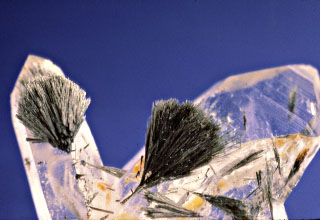Congratulations to the following 2004 Evolving Earth Student Grant recipients:
Clapham, Matthew E.
University of Southern California
“Late Permian bivalve paleoecology: initial steps towards dominance?”
Bivalves are thought to have become ecologically dominant after the end-Permian extinction. However, few paleoecological studies have actually been conducted. Did a Late Permian diversity increase actually correspond to initial stages of their rise to ecological importance?
Evans, Thomas V.
Graduate Student, Washington University in Saint Louis
“Hydrodynamic Properties of Bones to aid in Paleoenvironmental Reconstruction”
Skeletal elements from many individuals and a wide range of taxa would be placed in a river and their movement observed and tracked over time. Taphonomic data on depositional environments, fluvial alteration to bone, and residence time data would be recorded.
Hu, Shusheng
Ph.D candidate, University of Florida
“Early angiosperm pollen from the mid-Cretaceous Dakota Formation”
This project will focus on a study of early angiosperm pollen and their relationships to particular sedimentary environments. Also it will include changes in angiosperm diversity through late Albian to early Cenomanian from Dakota Formation in Kansas to Minnesota.
Karim, Talia S.
University of Iowa
“Lower Ordovician (Ibexian) trilobites from the Cow Head Group, western NF, CA”
Comprehensive collection and taxonomic descriptions of Lower Ordovician trilobite faunas from the Cow Head Group will shed light on higher level relationships of major trilobite groups and their “cryptogenic” origins.
Kessel, Benjamin J.
Utah State University
“Sequence Stratigraphy of Lower Paleozoic Facies, Ordos Basin, North China”
I plan to complete an in-depth sequence stratigraphic study of Lower Paleozoic rocks of the Ordos Basin, located on the western edge of the North China Block, in order to define depositional environments, sea level, and paleogeography during the Cambrian-Ordovician.
Koutnik, Michelle R.
University of Washington
“Assessing the Current State of Blue Glacier, Olympic Mountains, Washington”
Blue Glacier has only recently exhibited signs of retreat, indicating it is being influenced by changes in the Earth’s climate. Surface elevation measurements on the glacier will be taken in order to understand the current and future balance of this glacier, compared to past studies.
Kraatz, Brian P.
Graduate Student, The Regents of the University of CA, Berkeley
“Mammalian Faunal Changes During the Early Oligocene of Mongolia”
The research will assess the relative importance of environmental changes versus intrinsic biotic interactions in driving evolution. The study system is an exceptionally rich record of fossil mammals from the early Oligocene Hsanda Gol sequence, Tsagan Nor Basin, Mongolia.
Matthews, Kathryn
Doctoral Candidate, University of Pennsylvania
“Oceanic Upwelling in the Eastern Tropical Pacific: Experimental Proxy Development in Stony Corals”
For my dissertation research I reared 70+ coral fragments under heavy monitored ocean conditions in order to identify a quantitative link between the geochemical signature of the coral skeleton and the environmental conditions under which the coral grew.
Mihlbachler, Matthew
Columbia University and the American Museum of Natural History
“Alpha-Taxonomy, Phylogeny, and Biogeography of the Brontotheriidae”
the dissertation project is the alpha-taxonomy and phylogeny of the Brontotheriidae (Perissadactyla, Mammalia), including all known species from North America and Eurasia. This specific proposal is to gather data on Asian brontothere species and incorporate them into a phylogenetic analysis to examine the interrelationships of North American and Asian taxa.
Miller, Ian M.
Graduate Student, Yale University
“California real estate in Alaska?: Paleofloral constraints on suspect terranes”
The goal of the project is the paleolatitudinal restoration of “far-traveled” terranes (particularly the Yakutat terrane) in the Western Cordillera of North America using paleofloral estimates of MAT.
Takeuchi, Akinori
Ph.D student, Washington State University
“‘Rusty’ Paleosurfaces of the Pacific Northwest”
Geochemical characteristics of the intervolcanic paleosurfaces of the Columbia River Basalt group will be investigated and the Miocene paleoenvironmental condition of the Pacific Northwest will be reconstructed.

